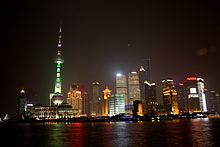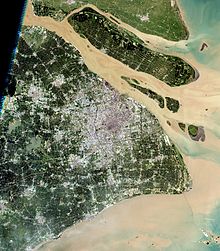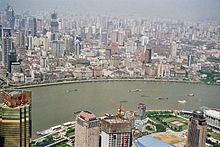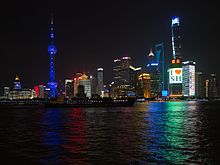Shanghai
![]()
This article is about the Chinese city. For other meanings, see Shanghai (disambiguation).
Shanghai or Shanghai (Chinese 上海, pinyin![]() ) is the most important industrial city in the People's Republic of China and one of the largest cities in the world.
) is the most important industrial city in the People's Republic of China and one of the largest cities in the world.
In addition to the city centre, which has a population of around 15 million, Shanghai also includes numerous surrounding districts up to 50 km away with a further population of around 8 million. While the inner city has a high building density and closed settlement form, a rural, rather provincial settlement structure dominates in the outlying districts. Of the total population of about 23 million (2010 census), 15.9 million are registered permanent residents (戶口 / 户口, hùkǒu) and 7,1 million temporary residents (流動人口 / 流动人口, liúdòng rénkǒu) with temporary residence permits (暫住證 / 暂住证, zànzhùzhèng).
Shanghai is a non-governmental city, i.e. it reports directly to the central government, and its status is that of a province. Its area of only 6340.5 km² (2012) is steadily increasing slightly due to ongoing land reclamation on the shallow bank of the Yangtze River Funnel (especially in the southeastern tip).
The Port of Shanghai is the largest container port in the world, handling 31.74 million TEUs per year (as of 2011). The port is also the largest by total throughput, with 736 million tonnes of goods in 2012.
The city is an important transport hub and a major cultural and educational centre with numerous universities, colleges, research institutes, theatres and museums.

Shanghai, Pudong skyline in the morning, August 2016
Name
The name of the city in Chinese is composed of the characters 上 (shàng) meaning "on", "situated high", "placed above" and 海 (hǎi) = "sea" and can be literally translated as "[city] above the sea".
For the German language, the Duden recommends the spelling Shanghai. Colloquially, Shanghai is also called "Gateway to the World", "Paris of the East" (東方巴黎 / 东方巴黎, Dōngfāng Bālí), "Dragon Head Metropolis" (龍頭 / 龙头, Lóngtóu) or "Pearl of the Orient" (東方明珠 / 东方明珠, Dōngfāng Míngzhū).
The official abbreviations of Shanghai in Chinese are Hù (滬 / 沪) and Shēn (申). The short name Hù - after a fishing device used in ancient times (a kind of fish fence made of bamboo) - is also used as a car license plate. The name Shēn refers to the noble Lord Chunshen (春申君, Chūnshēn Jūn), a politician and general from the time of the Warring States.
Geography
Geographical position
Shanghai is located in the estuary of the Yangtze River on the Huangpu River at 31° 14' north latitude and 121° 28' east longitude. Its neighboring provinces are Jiangsu to the northwest and Zhejiang to the southwest. The terrain of the province is flat. The average elevation above sea level is four meters. The highest mountain is She Shan with a height of 100 meters. It is accessible by cable car.
In 1949, the administrative area of the city had an area of 636 km². In 1958, ten counties with an area of 5274 km² (Baoshan, Chongming, Chuansha, Fengxian, Jiading, Jinshan, Nanhui, Qingpu, Shanghai, Songjiang, all located in Jiangsu Province) were incorporated into Shanghai.
Today, the city has an area of 6340.5 km². Of these, 1928.13 km² (30.4%) belong to the core city (Puxi) and the inner suburbs (Minhang, Baoshan, Jiading and Pudong), 4412.37 km² (69.6%) consist of outer suburbs and areas with rural settlement structure. The entire administrative area is more than twice the size of Saarland and has an extension of approximately 120 kilometers in the north-south direction and 100 kilometers in the east-west direction. Within the city limits are Chongming Island (the third largest island in China: 1041.21 km²) and other islands such as Changxing and Hengsha.
The Shanghai administrative area is rich in water resources with numerous rivers, canals and lakes (122 km² of water area), including the Jiangnan area, as the alluvial plain of the Yangtze River Delta is called. Jiangnan, which also includes parts of the eastern Chinese provinces of Jiangsu and Zhejiang, is characterized by a dense river network and has an area of 697 km² in Shanghai, accounting for eleven percent of Shanghai's total area.
The largest rivers in Shanghai are the Huangpu, the Suzhou, the Chuanyang and the Dingpu. The 113-kilometer-long Huangpu (its source is Lake Tai) divides the city in half (Puxi and Pudong); it is between 300 and 700 meters wide, averaging 360 meters. The ice-free river is Shanghai's main waterway.
The Suzhou River flows through Shanghai over a length of 54 kilometers and is on average 45 meters wide. Most of the lakes are located in the western part of Shanghai, the largest being Dianshan with an area of 62 km². Other urban areas in the Shanghai administrative area include Anting, Baoshan, Jiading, Jinshan, Qingpu and Songjiang.
The local dialect (Shanghaiic, also Shanghainese) is one of the variants of the East Chinese Wu dialect.
Geology
Shanghai lies in a large delta formed by the Yangtze River as it flows into the East China Sea. The entire lowland on both sides of the stream consists of dark loess-free alluvial soil formed by the sediments of the Yangtze. The delta plain, built up from its silt and crisscrossed by canals and dams, is one of China's most fertile areas and also its main supplier of cotton.
The Yangtze estuary is probably the filling in of an ancient part of the sea, and the many small inselbergs of the area were originally real islands. The delta formation moved the port city of Shanghai, originally founded on the sea, already 30 kilometers inland.
City breakdown
The city of Shanghai is divided into 16 municipalities.
Downtown
The city center (Puxi) is divided into seven districts, which are located west of the Huangpu River: Huangpu (黃浦區 / 黄浦区, Huángpǔ Qū), Xuhui (徐匯區 / 徐汇区, Xúhuì Qū), Changning (長寧區 / 长宁区, Chángníng Qū), Jing'an (靜安區 / 静安区, Jìng'ān Qū), Putuo (普陀區 / 普陀区, Pǔtuó Qū), Hongkou (虹口區 / 虹口区, Hóngkǒu Qū), and Yangpu (楊浦區 / 杨浦区, Yángpǔ Qū). On 20 May 2011, the former Luwan Municipality (盧灣區 / 卢湾区, Lúwān Qū) was dissolved and its area incorporated into Huangpu; Zhabei (閘北區 / 闸北区, Zháběi Qū) was added to Jing'an in 2015.
Periphery
In the immediate vicinity of the city centre there are four further urban districts, which are part of the urban area of the core city. These were transformed from counties into urban districts between 1988 and 1992. These include the Pudong Municipality (浦東新區 / 浦东新区, Pǔdōng Xīn Qū), located east of the Huangpu River. The latter was a county until 1992 and was named Chuansha. In 2009, the former Nanhui Municipality (南匯區 / 南汇区, Nánhuì Qū) was dissolved and its area incorporated into Pudong. In 1988, Baoshan (寶山區 / 宝山区, Bǎoshān Qū) has been transformed into a borough, in 1992 Jiading (嘉定區 / 嘉定区, Jiādìng Qū) and Minhang (閔行區 / 闵行区, Mǐnháng Qū).
Other surroundings
Five urban districts (these were converted from counties to urban boroughs between 1992 and 2016) are located further from the city center in rural areas outside the core city. In 1992 Jinshan (金山區 / 金山区, Jīnshān Qū) was converted to an urban borough, and in 1997 Songjiang (松江區 / 松江区, Sōngjiāng Qū), 1999 Qingpu (青浦區 / 青浦区, Qīngpǔ Qū), 2001 Fengxian (奉賢區 / 奉贤区, Fèngxián Qū) and 2016 Chongming (崇明區 / 崇明区, Chóngmíng Qū). The latter consists of the island of the same name, Chongming Dao, in the mouth of the Yangtze River and two smaller islands to the south.
See also: List of Shanghai municipalities
Climate
Shanghai has a subtropical maritime monsoon climate with four distinct seasons, with spring and autumn being comparatively short.
Shanghai lies on the border between a cool, humid maritime climate and a subtropical, warm monsoon climate. In winter, it is cold and humid, with temperatures averaging 3.4-5.6 °C. Occasionally there is also heavy frost. In the past, these low temperatures were very unpleasant for the inhabitants south of the Yangtze River, because it marked the "heating line", which means that south of the Yangtze River was not allowed to be heated. But because it can get very cold there too, this regulation was abolished.
In the hot and humid summer months, average temperatures of 23.1 to 27.2 °C and a humidity of up to 100 % are reached. Daytime highs occasionally reach up to 40 °C. In addition, numerous typhoons hit the city during the summer months, often with very heavy rainfall in a very short time.
The highest temperature was officially measured on 7 August 2013 at 40.8 °C, and the lowest on 19 January 1893 at -12.1 °C. The average annual temperature is 15.3 °C. The annual precipitation total is 1112 millimetres, 50% of which falls in the period from mid-May to mid-September (flood season). In this part of the year there are three distinct rainy periods: The "spring rains", the "plum rains" and the "autumn rains". In total, there are an average of 130 rainy days.
| Monthly average temperatures and precipitation for Shanghai
Source: | ||||||||||||||||||||||||||||||||||||||||||||||||||||||||||||||||||||||||||||||||||||||||||||||||||||||||||||||||||||||||||||||||||||||||||||||||||||||||||||||||||||||||||||||||||||||||||||||||

View from Shanghai Science and Technology Museum

Pudong on New Year's Eve 2011/2012

Satellite image of Shanghai, Landsat 7 August 15, 2005

The Covenant

Shanghai, Pudong skyline by night, August 2016
Questions and Answers
Q: What is the Chinese name for Shanghai?
A: The Chinese name for Shanghai is 上海.
Q: How many people lived in Shanghai in 2017?
A: In 2017, there were about 24,000,000 people living in Shanghai.
Q: What type of city is Shanghai?
A: Shanghai is a special province-level city in China ("municipality"), like Beijing, Tianjin, and Chongqing.
Q: Is it the biggest port in the world?
A: Yes, right now it is the biggest port in the world.
Q: How do you pronounce "Shanghai" in Shanghainese?
A: The pronunciation of "Shanghai" in Shanghainese is [zɑ̃.hɛ].
Q: How do you pronounce "Shanghai" in Mandarin?
A: The pronunciation of "Shanghai" in Mandarin is [ʂâŋ.xài].
Search within the encyclopedia